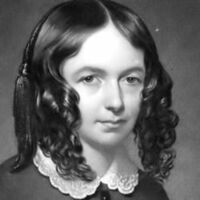Bertha in the Lane
By Genna Rhoswen
Thou and I, Dear, if we might?
Thy brown eyes have looks like birds
Flying straightway to the light:
Mine are older.-Hush!-look out-
Up the street! Is none without?
How the poplar swings about! (lines 120-126)
This is not the first instance the speaker mentions and calls attention to the fact that she and Bertha, her younger sister are alone. Why does the speaker do this? Why is the absence of any other audience so important to the speaker that she would mention it repeatedly? Her interjections, or anacoluthon do help readers to see that they are alone, but why is it important enough to establish it in the first place, and secondly, to iterate it?
The repetition emphasizes the state of being alone, but whose aloneness is being highlighted? The speakers? Bertha's? They are with each other but yet alone. In stanza 28, the speaker suggests that despite the absence of any other audience, she is anticipating the possibility of someone coming to see her to hear her last words before she dies. Perhaps she repeatedly mentions the absence in order to focus on her aloneness. She no longer has her fiancé and when she dies, she will die alone. The next stanza, however, she suggests the very opposite. Perhaps even though no one is currently there with them, there is the possibility that someone will come to see Bertha, rather than the speaker, but right now, Bertha is alone. She will have Robert, but she will not have her sister, who was "nigh a mother" to her (line 29). The speaker experiences the pain of loosing a lover and even though she speaks with endearments and affection, she suggests her sister's aloneness so that she too will feel pain-the pain of being alone.
The method the speaker uses to suggest absence is almost like litotes. The speaker affirms that there is nothing and no one near, but can her words be trusted? Suggesting a presence, and then affirming its absence leaves the eerie feeling that perhaps something is there. It's like telling a child not to fear the monster he claims to have heard in the closet. He might believe your reassurances, but the fear will still linger. He did hear something after all. The method parallels with her rhetoric of love towards her sister. As was mentioned, despite her loving rhetoric, in her interjections about her sister's reaction, it is obvious that Bertha is upset and pained. She gives a start. For example, we know that Bertha weeps because the speaker tells her, "Do not weep so" (line 155). The speaker affirms her younger sister that everything is as it should be, that it is better that Robert weds Bertha rather than her saying, "All was best as it befell" (line 156). But just as the reiterations of absence suggest the possible coming presence of someone or something into the audience, her loving language states the absence of bitterness, but communicates and implies the opposite. The painting images of absence, whether people or feelings of bitterness that create the opposite effect is a reflection of what she is really doing, creating pain for her sister as she herself is suffering.

